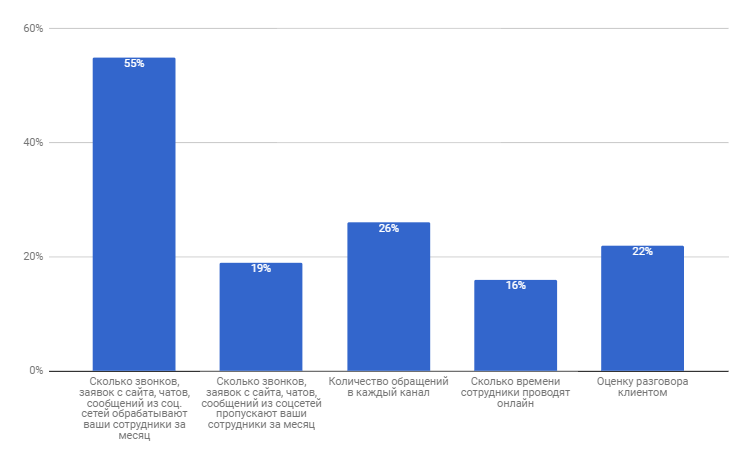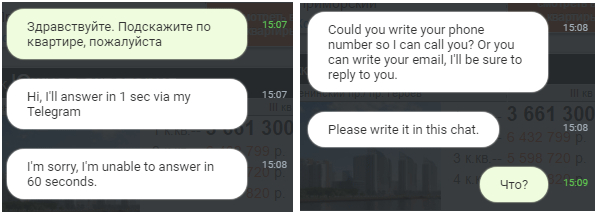Epic files in online chat rooms, or why sales do not grow
Do you know the situation? You wander through the website of an online store, bank or travel agency, your goal is to collect more information about a product or service. At some point you have questions that can be answered only with the help of a specialist. And the window of the online consultant appeared very well, you happily ask your operator questions and ... get a vague answer and a request to leave a phone number. This is not the worst option, sometimes you can stay completely unanswered specialist. This is how online chat rooms look, with which the business has not learned to work properly.
In this article, we analyze the main epic files in online chat rooms. So, chat rooms on the site are useless and can they be turned into a working tool to increase profits?

In November, the association of online trading companies ACIT published on vc.ru a study of digital communications retailers.
')
Phone calls (80%) and email (84%) are still a favorite way to contact the company. After them, the most popular are: online chat rooms - 68%, and then instant messengers (22%). It is in Russia. The statistics of western companies for the distant 2015 year says that even then 71% preferred to use chat rooms, and 67% of consumers used social networks and instant messengers. Calls and emails do not give up their positions yet, but it’s not easy to dismiss the new channels either - they are confidently gaining popularity, more and more customers want to communicate with the company in writing and in real time.
If you dig deeper and dive into the research data, you can see which indicators in the client service are monitored and controlled by retailers whose business belongs to the most highly competitive caste, the fight is fought for each client and the account goes on for seconds.
55% of retailers track how many requests / calls / messages in social networks are processed by employees.
At the same time, only 19% track how many messages from the same channels are passed by employees (by simple subtraction, we find out that 36% do not care how many customers are dissatisfied).
And only 22% track customer ratings.

It turns out that 78% of companies do NOT monitor how customers evaluate their work, and another half of them do NOT follow those messages that were not received and served by employees. In what this results in practice - we will see further, but for now, we note that correspondence with the client is a business. And business is time and money, yours and the client. Having missed the client once, you can not see him anymore - he will simply go where he will be answered. Quickly and to the point :)
If you look not from the client service and sales, but to approach the question from the marketing side, then everything looks even more sad. At every corner, marketers shout about end-to-end analytics (which is not easy to implement on a large company scale), while according to the same ACIT study, 48.4% of the surveyed companies do not use CRM at all (!!!). In practice, it is much easier (but not more efficient) to calculate the CPL (cost per lead). It is easier, less expensive and less responsible. The logic is this: we have a budget, from it we get so many leads at such a price. We reduce the cost of the lead - we are great, we increase - not very cool. However, the reality is that marketing should bring customers and money, not just leads. But to calculate the first is more difficult, technically and financially more expensive. And to count how many clients came from the chat is a pancake, it’s necessary to integrate everything, forward data, you need to change the processes inside. Simply the old fashioned way, and somehow “will pass by itself”. So, business is opposed to starting to track key indicators, count NPS (loyalty index), LTV (customer lifetime value) and become more efficient using modern ways of interacting with customers.
This year, as part of a large project, we studied how the operators of customer support services communicate in online chat rooms. The study was conducted by the content marketer LiveTex, for each industry she invented a legend (and sometimes even had two to check all cases) and went to ask questions in chats by industry. Thus, we checked the real estate industry, travel companies, car dealers, medical clinics, online retailers and banks. From intensive communication with our business in chat rooms to the middle of a research experiment, the girl started to twitch her right eye. Here it is, the domestic customer service in all its glory.
It turned out that a few companies provide adequate customer support in chat rooms. For most services in chat rooms - at best, blindly following the script or asking the client for his contacts. There is a demand for text channels. The channels themselves are there. And what do clients get?
About typical files, such as, “the operator does not respond quickly in the chat or redirects to another channel, does not greet or writes with errors,” we will not speak here. It is found in almost everyone and, apparently, ineradicably.
Especially for Habr, we chose “the best of the best” and did not forget to attach screenshots.
So, the nomination "Epic Fall" goes to the English bot on the Russian real estate website. There are no comments here - how many visitors of the Russian-language site will want to use the English interface? We did not give up at once, and still tried to reach the manager in this chat. What is the result? Instead of greeting, the manager silently throws his mail into the chat. Bingo!



The main mistake is the desire to follow the trends (implement the chat bot) without realizing the ultimate goal of this implementation. Chat bot should be the first line of support and resolve typical questions, passing the dialogue to the operator in cases where he cannot cope or the client wants it.
Global conclusion on real estate chats: chat in agencies is not seen as a channel for attracting and building customer loyalty, most often it is used to collect contacts. Meanwhile, the application here “lives” only 15 minutes and you need to “strike while hot”, take customer warm and fascinate with the first word.
According to the statistics that we managed to collect, with the proper use of online chat rooms in this area, consultations in the chat about the deadlines for the object, help with searching the site for planning options help close up to 80% of typical questions and regularly receive new leads for subsequent sale.
It would seem, too, a competitive market. People think about rest more often at work and do not mind discussing a vacation tour during a working meeting. Chat - perfect. But not everything is so rosy here. Oscar failure in digital communications goes to such a chatika.

The manager automatically asks questions about the script. When the client said that he was uncomfortable on the phone, the operator was completely angry. The final blow is the answer with a copied rude message.
Another "pleasantness" from the industry: On another site, the manager three times (!) Suggested leaving a mobile number "in case of a break in communication." And quite “aerobatics” - the manager in the chat figured out the primary needs of the client, and then offered the client to leave a phone number and transfer all the collected data to the right manager (so that he would call the client back, of course).
The main mistake is the low culture of communication of the operator and the transfer of the client to another channel.
Words are superfluous. Just look not timing answers on the screen. The continuation of the dialogue happened only because our content marketer conducted an experiment, was extremely persistent and waited in the chat to the last. Schrödinger's chat - he seems to be there and as if he does not.


The error is classic - the chat is installed, but it is simply not used.
Another problem with retailer chats is chat design, or rather its absence, a comeback from the 90s. But this is no longer a story about the very communication of the operators, but rather a question of aesthetic taste, which does not always concern those who install chat rooms to their site.
Case "shoemaker without shoes." We decided to ask in a chat about the services of a psychotherapist. The services of these doctors are not yet very popular, they are mainly used by people with incomes above average. It is logical to assume that at the other end of the communication will be appropriately sensitive and attentive staff of the clinic. The reality was disappointing.

What did we get in the end? Drive 2 thousand, waiting for a call. Very nice, let's go to another psychotherapist.
Error - a clinic that, by definition, should be attentive, involved and empathized with the patient, could not teach this to its operators.
Medical clinics still very often sinned with bad chat settings: service messages pop up randomly, the operator now appears in the network, then disappears. Yes, and chatting itself is very uneven: from a nice greeting, it is easy to pass to rude answers. For medical organizations, this looks deliberately unpleasant - a potential client has health problems, empathy is what is expected in the first place when contacting the clinic.
Well, let's see, finally, what kind of service in chat rooms are provided by banks. It is believed that they, along with online retailers, are at the forefront of digital customer service.
How do you like such a chain?

The usual client question was solved by four (!) Operators. They were disconnected, connected or transferred chat rooms to colleagues at any time. There was a feeling of interrupted incomplete communication. The client's confidence drops sharply, where can we talk about the quality support of the user on his client's path to purchase.
Error - operators are not able to quickly obtain the necessary information and work with databases, breaking the communication.
Oddly enough, it was from the banks that we found just a non-working chat and a chat that did not save the history of calls. As you can see, even banks - advanced players in the field of online consulting can easily get through with the service in text channels. There is nothing terrible here - the industry is developing and uniform standards of communication in digital channels with it (the main thing is not to stop improving and control how employees interact with customers).
Of course, when doing research, we met examples of excellent customer service in each industry, but there were significantly fewer. The overall picture is not very happy.
Finally, let's turn to the numbers. How many unikas come to the site of an online mid-size shop? According to LiveTex statistics, about 3% of all visitors to the site use the online chat window. Considering the above, one can only imagine how many potential customers fall off and go to the site to competitors due to poor-quality online service. And let's count. We take the average online store just from Yandex search results - wite.ru. We look at the attendance at similarweb (yes, yes, we know that he is lying, but his accuracy is enough for us) - 130k. An average of 130 x 0.03 = 3,900 people use the widget on the site every day. Half of them fall off simply because of the incompetent communication of the operator, this is no less than 1950. Suppose that everyone wanted to buy a desktop for 1000 rubles. 1950 x 1000 = 1 950 000 rub. Not bad.
We summarize. The list of the most common chat files:
The general conclusion to all this is one - the instrument is not to blame, but how it is worked with. If you treat the chat as well as your usual and leading phone and email so far, it will bring conversions, profits and loyal customers.
And what infuriates you most about online consultants (besides the fact that the windows “jump out” at the most inopportune moment - we know this problem and it is easily solved by the correct setting)? Maybe there are examples of good and bad service in chat rooms, social networks and instant messengers from different companies?
In this article, we analyze the main epic files in online chat rooms. So, chat rooms on the site are useless and can they be turned into a working tool to increase profits?

In November, the association of online trading companies ACIT published on vc.ru a study of digital communications retailers.
')
Phone calls (80%) and email (84%) are still a favorite way to contact the company. After them, the most popular are: online chat rooms - 68%, and then instant messengers (22%). It is in Russia. The statistics of western companies for the distant 2015 year says that even then 71% preferred to use chat rooms, and 67% of consumers used social networks and instant messengers. Calls and emails do not give up their positions yet, but it’s not easy to dismiss the new channels either - they are confidently gaining popularity, more and more customers want to communicate with the company in writing and in real time.
If you dig deeper and dive into the research data, you can see which indicators in the client service are monitored and controlled by retailers whose business belongs to the most highly competitive caste, the fight is fought for each client and the account goes on for seconds.
55% of retailers track how many requests / calls / messages in social networks are processed by employees.
At the same time, only 19% track how many messages from the same channels are passed by employees (by simple subtraction, we find out that 36% do not care how many customers are dissatisfied).
And only 22% track customer ratings.

It turns out that 78% of companies do NOT monitor how customers evaluate their work, and another half of them do NOT follow those messages that were not received and served by employees. In what this results in practice - we will see further, but for now, we note that correspondence with the client is a business. And business is time and money, yours and the client. Having missed the client once, you can not see him anymore - he will simply go where he will be answered. Quickly and to the point :)
If you look not from the client service and sales, but to approach the question from the marketing side, then everything looks even more sad. At every corner, marketers shout about end-to-end analytics (which is not easy to implement on a large company scale), while according to the same ACIT study, 48.4% of the surveyed companies do not use CRM at all (!!!). In practice, it is much easier (but not more efficient) to calculate the CPL (cost per lead). It is easier, less expensive and less responsible. The logic is this: we have a budget, from it we get so many leads at such a price. We reduce the cost of the lead - we are great, we increase - not very cool. However, the reality is that marketing should bring customers and money, not just leads. But to calculate the first is more difficult, technically and financially more expensive. And to count how many clients came from the chat is a pancake, it’s necessary to integrate everything, forward data, you need to change the processes inside. Simply the old fashioned way, and somehow “will pass by itself”. So, business is opposed to starting to track key indicators, count NPS (loyalty index), LTV (customer lifetime value) and become more efficient using modern ways of interacting with customers.
Why don't chats sell?
This year, as part of a large project, we studied how the operators of customer support services communicate in online chat rooms. The study was conducted by the content marketer LiveTex, for each industry she invented a legend (and sometimes even had two to check all cases) and went to ask questions in chats by industry. Thus, we checked the real estate industry, travel companies, car dealers, medical clinics, online retailers and banks. From intensive communication with our business in chat rooms to the middle of a research experiment, the girl started to twitch her right eye. Here it is, the domestic customer service in all its glory.
It turned out that a few companies provide adequate customer support in chat rooms. For most services in chat rooms - at best, blindly following the script or asking the client for his contacts. There is a demand for text channels. The channels themselves are there. And what do clients get?
About typical files, such as, “the operator does not respond quickly in the chat or redirects to another channel, does not greet or writes with errors,” we will not speak here. It is found in almost everyone and, apparently, ineradicably.
Especially for Habr, we chose “the best of the best” and did not forget to attach screenshots.
Nedvizhka
So, the nomination "Epic Fall" goes to the English bot on the Russian real estate website. There are no comments here - how many visitors of the Russian-language site will want to use the English interface? We did not give up at once, and still tried to reach the manager in this chat. What is the result? Instead of greeting, the manager silently throws his mail into the chat. Bingo!



The main mistake is the desire to follow the trends (implement the chat bot) without realizing the ultimate goal of this implementation. Chat bot should be the first line of support and resolve typical questions, passing the dialogue to the operator in cases where he cannot cope or the client wants it.
Global conclusion on real estate chats: chat in agencies is not seen as a channel for attracting and building customer loyalty, most often it is used to collect contacts. Meanwhile, the application here “lives” only 15 minutes and you need to “strike while hot”, take customer warm and fascinate with the first word.
According to the statistics that we managed to collect, with the proper use of online chat rooms in this area, consultations in the chat about the deadlines for the object, help with searching the site for planning options help close up to 80% of typical questions and regularly receive new leads for subsequent sale.
Travel Agencies
It would seem, too, a competitive market. People think about rest more often at work and do not mind discussing a vacation tour during a working meeting. Chat - perfect. But not everything is so rosy here. Oscar failure in digital communications goes to such a chatika.

The manager automatically asks questions about the script. When the client said that he was uncomfortable on the phone, the operator was completely angry. The final blow is the answer with a copied rude message.
Another "pleasantness" from the industry: On another site, the manager three times (!) Suggested leaving a mobile number "in case of a break in communication." And quite “aerobatics” - the manager in the chat figured out the primary needs of the client, and then offered the client to leave a phone number and transfer all the collected data to the right manager (so that he would call the client back, of course).
The main mistake is the low culture of communication of the operator and the transfer of the client to another channel.
Retail
Words are superfluous. Just look not timing answers on the screen. The continuation of the dialogue happened only because our content marketer conducted an experiment, was extremely persistent and waited in the chat to the last. Schrödinger's chat - he seems to be there and as if he does not.


The error is classic - the chat is installed, but it is simply not used.
Another problem with retailer chats is chat design, or rather its absence, a comeback from the 90s. But this is no longer a story about the very communication of the operators, but rather a question of aesthetic taste, which does not always concern those who install chat rooms to their site.
Medical Clinics
Case "shoemaker without shoes." We decided to ask in a chat about the services of a psychotherapist. The services of these doctors are not yet very popular, they are mainly used by people with incomes above average. It is logical to assume that at the other end of the communication will be appropriately sensitive and attentive staff of the clinic. The reality was disappointing.

What did we get in the end? Drive 2 thousand, waiting for a call. Very nice, let's go to another psychotherapist.
Error - a clinic that, by definition, should be attentive, involved and empathized with the patient, could not teach this to its operators.
Medical clinics still very often sinned with bad chat settings: service messages pop up randomly, the operator now appears in the network, then disappears. Yes, and chatting itself is very uneven: from a nice greeting, it is easy to pass to rude answers. For medical organizations, this looks deliberately unpleasant - a potential client has health problems, empathy is what is expected in the first place when contacting the clinic.
Banks
Well, let's see, finally, what kind of service in chat rooms are provided by banks. It is believed that they, along with online retailers, are at the forefront of digital customer service.
How do you like such a chain?

The usual client question was solved by four (!) Operators. They were disconnected, connected or transferred chat rooms to colleagues at any time. There was a feeling of interrupted incomplete communication. The client's confidence drops sharply, where can we talk about the quality support of the user on his client's path to purchase.
Error - operators are not able to quickly obtain the necessary information and work with databases, breaking the communication.
Oddly enough, it was from the banks that we found just a non-working chat and a chat that did not save the history of calls. As you can see, even banks - advanced players in the field of online consulting can easily get through with the service in text channels. There is nothing terrible here - the industry is developing and uniform standards of communication in digital channels with it (the main thing is not to stop improving and control how employees interact with customers).
Of course, when doing research, we met examples of excellent customer service in each industry, but there were significantly fewer. The overall picture is not very happy.
Finally, let's turn to the numbers. How many unikas come to the site of an online mid-size shop? According to LiveTex statistics, about 3% of all visitors to the site use the online chat window. Considering the above, one can only imagine how many potential customers fall off and go to the site to competitors due to poor-quality online service. And let's count. We take the average online store just from Yandex search results - wite.ru. We look at the attendance at similarweb (yes, yes, we know that he is lying, but his accuracy is enough for us) - 130k. An average of 130 x 0.03 = 3,900 people use the widget on the site every day. Half of them fall off simply because of the incompetent communication of the operator, this is no less than 1950. Suppose that everyone wanted to buy a desktop for 1000 rubles. 1950 x 1000 = 1 950 000 rub. Not bad.
We summarize. The list of the most common chat files:
- low response rate (the client is ready to wait for a response in the chat no longer than 30-60 seconds);
- the rudeness of the operators (do not forget that the client pays you, which means that he must be priceless and loved);
- ignoring customer questions (no comments);
- ignoring customer emotions (empathy, everything);
- request to leave the phone when the client is not ready to do this (if the client turned in the text channel, it means that he has a number of reasons. You do not need to ignore this);
- technical problems with chat rooms and chat bots (infuriates when a stupid bot does not answer the question and does not switch to the operator).
The general conclusion to all this is one - the instrument is not to blame, but how it is worked with. If you treat the chat as well as your usual and leading phone and email so far, it will bring conversions, profits and loyal customers.
And what infuriates you most about online consultants (besides the fact that the windows “jump out” at the most inopportune moment - we know this problem and it is easily solved by the correct setting)? Maybe there are examples of good and bad service in chat rooms, social networks and instant messengers from different companies?
Source: https://habr.com/ru/post/345772/
All Articles